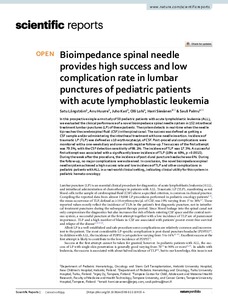Bioimpedance spinal needle provides high success and low complication rate in lumbar punctures of pediatric patients with acute lymphoblastic leukemia
Lohi Olli; Sievänen Harri; Långström Satu; Kari Juho; Huurre Anu; Palmu Sauli
https://urn.fi/URN:NBN:fi-fe2022081154619
Tiivistelmä
In this prospective single-arm study of 50 pediatric patients with acute lymphoblastic leukemia (ALL), we evaluated the clinical performance of a novel bioimpedance spinal needle system in 152 intrathecal treatment lumbar punctures (LP) of these patients. The system detects in real-time when the needle tip reaches the cerebrospinal fluid (CSF) in the spinal canal. The success was defined as getting a CSF sample and/or administering the intrathecal treatment with one needle insertion. Incidence of traumatic LP (TLP) was defined as >= 10 erythrocytes/mu L of CSF. Post-procedural complications were monitored with a one-week diary and one-month register follow-up. The success of the first attempt was 79.5%, with the CSF detection sensitivity of 86.1%. The incidence of TLP was 17.3%. A successful first attempt was associated with a significantly lower incidence of TLP (10% vs 40%, p = 0.0015). During the week after the procedure, the incidence of post-dural puncture headache was 6%. During the follow-up, no major complications were observed. In conclusion, the novel bioimpedance spinal needle system achieved a high success rate and low incidence of TLP and other complications in pediatric patients with ALL in a real-world clinical setting, indicating clinical utility for this system in pediatric hemato-oncology.
Kokoelmat
- Rinnakkaistallenteet [19207]
